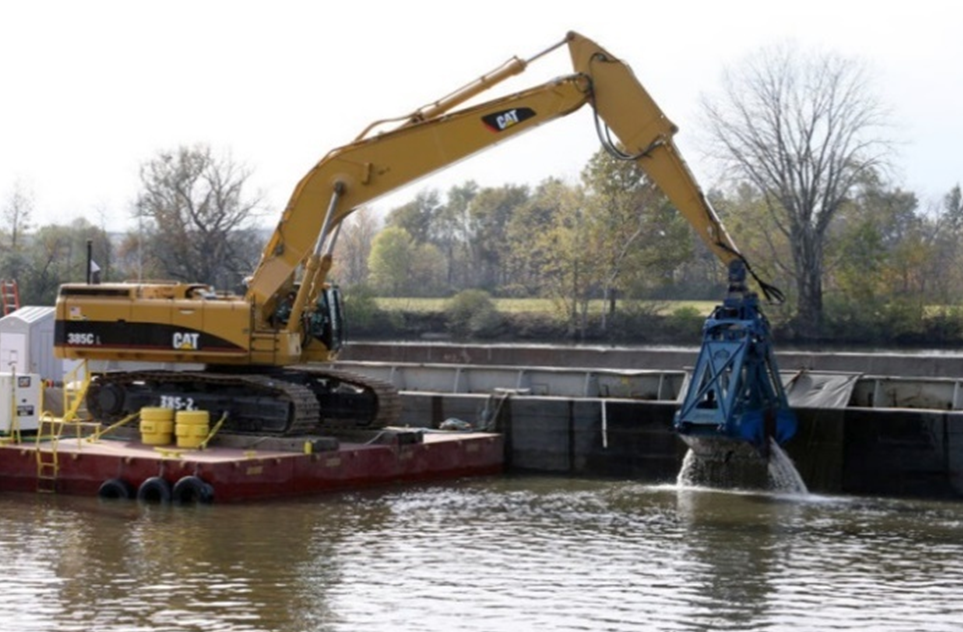Planktonic:
In-water Prevention Strategy
Limited Supporting Field Data
Benthic:
In-water Prevention Strategy
Limited Supporting Field Data
Dredging is the physical removal of sediment from the bottom of a water body. In the context of HCB control, dredging is performed to reduce the supply of nutrients from the sediment (internal loading) to the water column. There are many different dredging techniques available, but most can be categorized as either hydraulic or mechanical dredging. Hydraulic dredging works by sucking sediment through a tube to a barge or offshore location. Mechanical dredging involves excavating the sediment with backhoes, clamshells, draglines, or equipment. Dredging for HCB control purposes usually targets the upper, nutrient-enriched sediment layer (for example, 10–100 centimeters). The amount of dredged material to be removed can be determined by measuring phosphorus concentrations at varying depths in bottom sediments.
| PLANKTONIC AND BENTHIC |
|
EFFECTIVENESS
|
|
NATURE OF HCB
|
|
ADVANTAGES
|
|
LIMITATIONS
|

Figure 1. Mechanical dredging on the upper Hudson River.
Source: USEPA.
Dredging can be a useful technique for water bodies that have experienced historical nutrient over-enrichment such that internal recycling of nutrients from the sediment is sufficient to support blooms (Peterson 1982). It has the highest potential for success in lakes where sediment fluxes are the dominant nutrient loading source and external nutrient loads have been controlled (Bormans, Marsálek, and Jancula 2015). Dredging also has been successful when combined with other control techniques, such as sediment phosphorus inactivation (Lürling and Faassen 2012).
COST ANALYSIS
Dredging is one of the most expensive HCB control techniques (Bormans, Marsálek, and Jancula 2015, Hudson 1998, Peterson 1982). The cost can vary greatly based on the area, depth, and nature of the material to be dredged. Pre-dredging costs typically include bathymetric surveys, permitting, and chemical analysis of the material to be dredged. Disposal costs are higher if the material is contaminated or if the disposal area is far from the lake or reservoir. Conversely, disposal costs can be lower if the material can be beneficially reused (for example, applied to pasture or crops as a soil amendment). The Illinois Environmental Protection Agency (Hudson 1998) estimated that typical costs of dredging in 2020 dollars are $8–$24 per cubic yard for hydraulic dredging and $13–$48 per cubic yard for mechanical dredging. For other examples, the average cost was $63,443/acre (Appendix C.2 in HCB-1). Although is it possible to dredge water bodies of various size, costs may limit dredging’s practical use for HCB control to relatively small or shallow water bodies.
Relative cost per growing season: Dredging
| ITEM | RELATIVE COST PER GROWING SEASON |
| Planning/Permitting | $$ |
| Material | $ |
| Equipment | $$$ |
| Labor | $$$ |
| Disposal | $$ |
| OVERALL | $$$ |
REGULATORY AND POLICY CONSIDERATIONS
In the United States, Sections 401 and 404 of the Clean Water Act (33 U.S.C. §§1251–1387) require that those persons or businesses that propose dredging within navigable waters obtain a permit from the U.S. Army Corps of Engineers, the state regulatory agency, and (in some cases) USEPA. Permitting requirements can be streamlined somewhat by joint permit applications to multiple agencies. Typical permit application requirements include the quantity or extent of dredging, disposal location and method, and expected environmental impacts. In some cases, testing of the dredged material will be required, which could affect disposal requirements.
Dredging can have potential co-benefits of increased lake volume, enhanced boat navigation, removal of nuisance macrophytes, enhanced fish production, and removal of toxic sediments (Peterson 1982). In fact, most dredging projects are motivated by one or more of these drivers rather than by HCB control. In many settings, the level of stakeholder support for dredging projects will be tied to these co-benefits.
REFERENCES
Bormans, Myriam, Blahoslav Marsálek, and Daniel Jancula. 2015. “Controlling internal phosphorus loading in lakes by physical methods to reduce cyanobacterial blooms: a review.” Aquatic Ecology 50. doi: https://doi.org/10.1007/s10452-015-9564-x.
Hudson, Holly. 1998. “Lake dredging.” Lake Notes. doi: https://epa.illinois.gov/content/dam/soi/en/web/epa/documents/water/conservation/lake-notes/lake-dredging.pdf.
Lürling, M., and E. J. Faassen. 2012. “Controlling toxic cyanobacteria: effects of dredging and phosphorus-binding clay on cyanobacteria and microcystins.” Water Resources 46 (5):1447-59. doi: https://doi.org/10.1016/j.watres.2011.11.008.
Peterson, Spencer A. 1982. “Lake restoration by sediment removal.” Journal of the American Water Resources Association 18 (3):423-436. doi: https://doi.org/10.1111/j.1752-1688.1982.tb00009.x.


